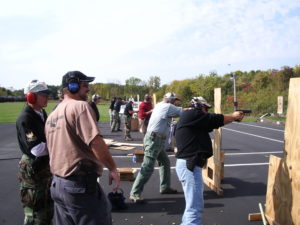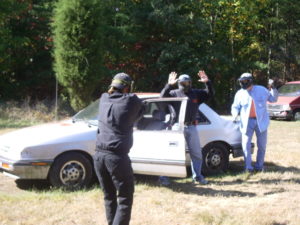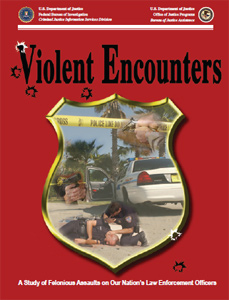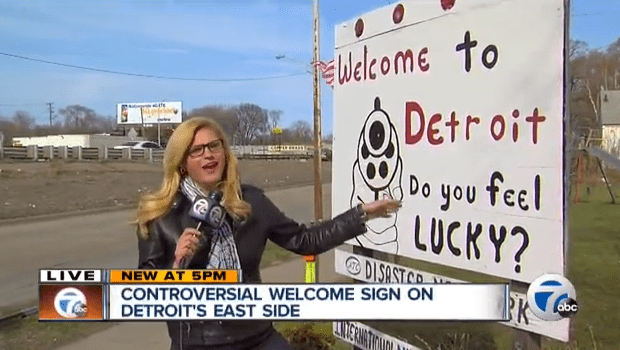Written by Greg Ellifritz. Republished with permission from activeresponsetraining.net
Most people “know” that criminal attackers don’t take formal training classes and they assume that if an honest citizen has a couple of good training classes under his belt, he will beat the untrained, poorly skilled criminal in a fight. This may be true, but in some cases it’s not. Let’s look at the research . . .
The FBI put out a publication several years ago titled “Violent Encounters: A Study of Felonious Assaults on Our Nation’s Law Enforcement Officers.” Researchers identified 40 cases of serious attacks on police officers. In each case, they interviewed both the officers and the attackers involved. They investigated the training, weapons usage, practice habits, and attitudes towards violence. The results were remarkable.
The first thing the researchers learned: our assumptions about criminals not training are wrong. Nearly 40 percent of the criminal attackers in this study had received formal firearms training (mostly in the military). More than 80 percent of the criminal attackers regularly practiced with their firearms, with an average number of 23 Practice Sessions Per Year.
The bad guys conducted these practice sessions in trash dumps, wooded areas, back yards and “street corners in known drug trafficking areas.” In other words, the practice sessions occurred in realistic environments, under conditions similar to those the attackers were likely to face in combat.
The cops involved in these incidents all had some type of formal training at their departments. On average, they fired their guns 2.5 times per year. All of that training was conducted on a static shooting range that had little relevance to the environmental conditions where the cops actually fought.
In this sample study the criminal was better trained than the cop. If you aren’t a cop and carry a concealed weapon to defend against criminal attack, how does your training stack up against the bad guys in this study?
Many people who carry a firearm for self-defense take a state-mandated concealed carry course and call it good. These courses are geared to novices; they focus on safe firearms handing, basic marksmanship and legal issues surrounding armed self-defense. They don’t count as “formal training.” The instructors don’t teach anything that could be considered “tactical”: presentation, close-quarters combat, escape and evasion, etc.
And then there’s practice. How many of armed self-defenders shoot their weapons 23 times a year in a realistic environment? Some shooters who achieve that level of frequency—by shooting at a static target at a gun range. I don’t know many people other than hobbyist shooters who seek-out proper self-defense training.
In short, the average CCW permit holder is outmatched by any violent criminal similar to the type interviewed in this study. But it’s not all about training. When calculating your odds of survival in an armed encounter, experience is an even more important variable.
The “Violent Encounters” study compared the criminals’ experience levels compared to the cops. More than 40 percent of the criminals identified in the study had at least one gunfight experience before attacking the officer. Twenty-five percent of the attackers had been involved in more than five gunfights.
Practical, real world experience of a gunfight changes one’s perceptions of fighting with a gun. One of the interviewed criminals summed it up perfectly when he stated: “I made up my mind that nobody was going to shoot me again.”
Take a look at this guy. He was 29-years-old when he was killed by a homeowner during a home invasion. He had previously been shot in 10 other incidents and survived. Do you think that he might have picked up a few insights about gunfighting during some of those shootings?
I train cops for a living. Its my job to talk to cops about what works and what doesn’t. I don’t know a single cop who has been involved in 10 on-the-job gunfights.
Less than 25 percent of the officers The officers in the Violent Encounters study had been involved in a shooting incident before their attacks. The largest number of shootings in which any of the officers had been involved: three. On average, each officer had been involved in four incidents in which they were legally justified in shooting a criminal, but they chose not to shoot.
As a result of their differing levels of training and experience, both groups—criminals and cops—had different attitudes The officers went out of their way to avoid gunfights. The study noted “It appeared clear that none of the officers were willing to use deadly force against an opponent if other options were available.”
Contrast that with the attitude of their attackers. The report noted “Offenders typically displayed no moral or ethical restraints in using firearms . . . In fact, the street combat veterans survived by developing a shoot- first mentality.”
This study showed that the police officers were outmatched by their criminal opponents in every domain studied…training, experience, and mindset. If trained police officers are outmatched, where does that put the average citizen? It is actually quite astounding that citizens do as well as they do when they confront violent criminals.
Short of becoming a thug, what can you, a cop or armed citizen, do to better his training and experience?
The first thing that you could do is to increase the frequency of your practice sessions. Shorter, more frequent practice sessions are more effective than long sessions that are spaced months apart. Even if you don’t have regular access to a firing range, you can still practice drawing your gun and dry firing. There have been several research studies that have shown dry firing to be just as valuable as real shooting for maintaining marksmanship abilities.
 Marksmanship and practice is easy. Gaining valuable experiences is more difficult. If you aren’t regularly engaging in gunfights or dealing with criminal violence it is tough to acquire.
Marksmanship and practice is easy. Gaining valuable experiences is more difficult. If you aren’t regularly engaging in gunfights or dealing with criminal violence it is tough to acquire.
One idea is to learn from the experiences of others. Even if it isn’t a direct experience, there are lots of lessons to learn by studying the success and failure of others. I make a point to interview as many gunfight participants (on both sides of the law) as possible. All of them have taught me valuable lessons that I’m glad I didn’t have to learn on the street. If you don’t know any gunfighters, read as much as you can on the subject. Many of the monthly firearms magazines have feature articles that provide a detailed analysis of a certain gunfight. Study those articles and read as many books as you can find on the topic.
The other method of acquiring experience is to do so in the context of force-on-force training. The best type of this training is conducted at professional shooting schools and uses tightly-scripted professional role players. It is costly, but worth the expense. You will learn more in one day of this type of training than you will learn in weeks of practicing by yourself.
 If you don’t have access to such training, practicing scenarios with a few friends or family members using airsoft guns also works well. Before undertaking such activity, make sure there are no live weapons in the area, have a safety monitor to stop the scenario if a dangerous situation is created, and make sure all participants are wearing adequate protective gear.
If you don’t have access to such training, practicing scenarios with a few friends or family members using airsoft guns also works well. Before undertaking such activity, make sure there are no live weapons in the area, have a safety monitor to stop the scenario if a dangerous situation is created, and make sure all participants are wearing adequate protective gear.
The mindset, training, and experiences of your opponent are outside of your sphere of influence. You can’t control them. You can control those factors in your own life. Practice often, study, and do everything you can to make the odds in your favor. But above all: don’t underestimate your enemy.





Excellent article!
Greg Ellifritz is part of the exceptional staff at the Tactical Defense Institute in southern Ohio.
I’ve been there several times. First-rate training in weapons, tactics, and mindset at surprisingly affordable prices.
http://www.tdiohio.com
“First-rate training in weapons, tactics, and mindset at surprisingly affordable prices.”
You can say that again. I just got done with Handgun I-III a couple weeks ago. It blew my mind. I thought I knew how to shoot before, I was wrong. They improved or refined, literally, every single aspect of my handgun skills. And at only $175 per class and only two students to every instructor the value is hard to beat.
1) A fascinating article that does indeed refute much that I’ve been told about BGs training and practice with firearms. Most excellent.
2) I do however have to question one aspect of the study, sampling technique. I looked at the original to see how data sampling was handled and noticed that, out of 800 cases given to them they chose to write about 40. Those 40 may be an accurate sample be right in the middle of the bell curve or they may be far to the right on the training/practice issues.
Another possible explanation could be that the police submitted their cases where officers were most severely hurt or faced with unusual tactics and techniques, a not unreasonable choice, because they offer the most valuable lessons. And then the authors chose may have done the same thing again a reasonable and valid choice.
Which could possible bias the sample, twice.
I need to get to work, will look closer when I get home.
NukemJim
You also have to consider that the author is a professional trainer and has “a dog in the fight”.
Excellent article. I had seen a comment on TTAG a couple of weeks ago where the respondent gave greater credence to hunters than “street thugs” in a gun fight. To me, the street thugs mind set starts them ahead of the hunter (and, currently, myself) every time. They don’t care. This is how they make their bones. Law-abiding, hunting citizens will look for a way to avoid deadly force.
Happy shooting, dv
You ever hear a statistic and say to yourself, “That does not sound right”. While I agree with the overall angle/premise, BD’s training twice a month sounds high. Further skewing these stats is BD’s who take on cops are not your average BD’s.
Not taken into account into this is the fact that many BD’s have non-firearms training/experience that helps out bunches in a gunfight. Most have been in several fights with no weapons and/or with a weapon other than a gun. They are used to operating in code red and code black territory. This training also helps when the BD does not have a gun to begin with. What is the stat for cops who get shot with their own gun? That means a BD took the cop’s gun away and used in on him/her.
There is so much to learn from this and talk about. Good article.
“Further skewing these stats is BD’s who take on cops are not your average BD’s.”
You can’t choose your opponent.
Did anyone notice the slant of the linked article? The way it reads, Turner was a “father of two,” “trying to stay out of trouble” and certainly no home invader, at least according to the plentiful interviews with sympathetic relatives. As for those ten prior shootings, well, “he was blessed” to have survived. And then the obligatory “demand for justice.” Tom Wolfe is due a royalty check.
This was a REAL eye opener for me. I hadn’t ever thought of bad guys training that much, nor had I thought much of their accumulated street experience. I need to train better AND more often. I’m also going to have to change my mindset about bad guys abilities. This was EXCELLENT info, even if the study has bias in it, because we can now assume that bad guys train and plan, and we can make adjustments for that.
Interesting piece. Thanks. The 40 selected cases, while probably not representative of the average street thug, is a good reminder never to underestimate the enemy and to take training and preparation even more seriously.
This was a really good read.
While I think the article is a good read, let’s not forget we’re not installing an alarm in the car for the ‘pro’ car thief, we’re not putting a lock on the door to prevent the skilled lock picker from getting in, and not carry a gun to fight with the mafia hit man.
While the cops daily business deals with these guys, the average Joe has a way greater chance of running into some junkie than running into a pro.
My 2c,
Bob
I agree with Bob. I have seen plenty of surveillance videos of bad guys that are obviously morons. That said, I am sure there are “pros” out there and they are much fewer in number. Nevertheless, it is a great idea to practice for the “pros”. If we ever encounter a moron, the odds will be stacked even more in our favor. If we encounter a “pro”, well then we have done the best that we possibly can.
[REALLY SUPERB ARTICLE and good comments]
Practice for the pros! (I like it!)
We have a combatives training group where we do practice these things, and my standard advice is to practice for “your own evil twin” at a BARE MINIMUM.
Expect your attacker to be younger, stronger, faster, sneakier, using more violence, etc.
You don’t pick your mugger; your mugger picks you.
In the moment, the guy is totally certain he can “take you” — not only that but also that he will “get your stuff” and he will “not get hurt”.
While he can be wrong, if he is wrong very often he ends up dead, in jail, or the hospital.
If he wasn’t certain of winning he would bring more friends, more weapons, or use better tactics (like subterfuge, extreme violence, or more surprising attacks.)
What will the threat look like? We don’t know, but we do know it won’t look like we expect….
Great work!
A thought-provoking article. I’m sure the study is imperfect, but it certainly underlines the age-old advice: never underestimate your opponent.
I heard an Ayoob interview in which he described how bad guys teach other gun grabs and retention whilst incarcerated.
It is actually quite astounding that citizens do as well as they do when they confront violent criminals.
This was an excellent article, but the above comment shows its flaw. It is not astounding that citizens perform well against violent criminals. It’s actually very natural.
Of the author’s three performance keys — experience, training and mindset — the one that makes the most difference is mindset.
In a cops versus criminal shootout, the criminal has made a decision to fight or die. The BG’s only option is prison. The policeman has also made a decision — to catch or kill the crook. Neither can disengage.
In a criminal versus citizen shooting, the dynamics are completely different. The criminal knows that escape is a viable option, because the citizen has no interest in chasing the BG and arresting him. Likewise, the citizen’s mindset is fight or die — very much like the BG’s mindset when facing the police.
The cornered rat fights hardest.
Good point, Ralph.
Another factor is where it happens. Most successful DGUs happen when a BG breaks into someone’s house. The BG has made an assessment that nobody is home or likely to resist. If the intended victim is alerted he will often take an advantageous defense position. The BG may be better prepared mentally to use force but he has walked into an ambush. That is a situation where the best guy doesn’t usually win.
Exactly:
– Fighting on known ground.
– Standing on the defensive, likely in some sort of cover or concealment.
– Fighting to defend one’s family, vs trying to steal a DVD player.
Really good article.
Ralph, there is another aspect to this area of mindset. While what you say is true once action has been initiated; there is the question of initiation.
The difference between his mindset and a LEO is huge and there is an even vaster gulf between the BG’s thinking and a citizen, even a trained citizen. The BG prides himself on being the threat. He is the instigator of violent action. He is looking to rape, pillage and plunder whereas; the LEO is always being reactive. He can not see a BG, jump from his patrol car and open fire.
Years ago, I had an officer explain to me the effect of that reality. He said that police don’t view the world as businessmen and hippies, housewives and hookers. He said to the police it is only us and them; meaning his only allies were other officers. Everyone else was a potential threat. That mindset has created problems between the police and the community, but you can easily see why the police must take that view. The problem is, even seeing the world that way, the LEO is always at a disadvantage and the trained citizen even more so.
I don’t really see a way to overcome this one piece of the problem other than training and even that will only make one better at reacting, but you will still be reacting.
Most gun owners do not take any training beyond a few range trips, and 99% are not bad people intent on hurting innocents with firearms so some of the savagery may be missing. I also believe luck and fate play a huge part in any conflict, and it’s hard to train for that.
I want to encourage people to practice moving to avoid being shot as well as moving and shooting. You can practice both safely with airsoft. (If your evasion isn’t good enough and a friend shoots you with a plastic airsoft BB, you’ll be fine. Of course you cannot practice that with real ammunition.) And you can practice moving and shooting in an appropriate location. For me, that means a three hour drive to the nearest National Forest to an isolated and safe location. But I simply make a weekend out of it. I make multiple targets from inexpensive materials such as paper plates and old t-shirts. I use sticks in the forest with some string to make a “T” and hang the old t-shirt on it. Then I put the paper plate on top and draw a face on it with a marker. And voila, my own private shooting range where I can practice moving and shooting at those targets. I can also practice moving to cover or concealment (such as a camp chair or tree trunk) and shooting from behind.
I disagree with the author that a person needs to practice twice a month forever. Sufficient training that creates “muscle memory” stays for a very long time. I played a lot of table tennis (ping pong) in high school and then stopped. When I played for the first time in 20 years, I was immediately very good. And within two games, I was playing at 90% or better of my original skill level. Now I am not recommending that people train every 20 years. However it does illustrate that our brains retain a substantial level of skill for a very long time.
As for shorter periods between practice, I have an interesting track record with archery. After Fall hunting season, I store my equipment. When I pull it out in July every year to practice, I shoot right on target immediately. It doesn’t take days of additional practice to get back to where I was last season. I’m still “there”.
I believe that many people, thinking that they have to train twice a month for a significant benefit, will not bother to train at all. While twice a month would be great (and expensive!), even once or twice a year — every year — would be highly beneficial. We all hear that it is better to have a gun rather than no gun at all during a violent attack. Well I say the same applies to training: some training (once a year) is better than no training at all. And training once a year is something that everyone should be able to do.
Having been in a near DGU, being around inmates at various foundries and other workplaces, having a Defense Attorney friend, being in charge of weekend security, and being a turnkey; I can say that most of the criminals are none too bright and when they commit crimes it sometimes involves being under the influence of drugs and alcohol.
I am sure that some of the criminal element does practice the subjects mentioned in the article, but if the criminals have any brains, they would practice white collar or fraud type crimes versus being at risk of being blown away by some cop or armed citizen.
Another reason, I really do not think the Goblins practice much is the rounds fired to hit ratio versus the LEOs. Both are terrible, but the Goblins is more than twice as bad as the LEOs.
In addition, it seems that innocent bystanders are hit more than the Goblins in the gang shootings.
It seems that the Goblins carry more concealable small caliber weapons from LEO reports.
I appreciated this well-written article, but statistically it seems to suggest that the “average” BG one would most likely encounter would be a bad guy right out of the movie “Heat” (Robert De Niro, Val Kilmer or Tom Sizemore). Those were BAD dudes–or rather actors portraying REALLY bad dudes. Always best to be at one’s ready best, but if one of the aforementioned guys comes busting through my door, I’m toast!
Comments are closed.